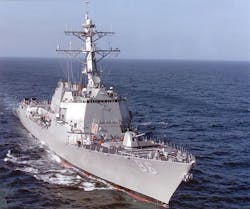Raytheon moves forward in developing new missile-defense shipboard radar for Burke destroyer
Officials of the Naval Sea Systems Command in Washington announced a $110.2 million contract modification Tuesday to the Raytheon Co. Integrated Defense Systems segment in Sudbury, Mass., for fiscal 2017 low-rate initial production long-lead material in support of the AMDR and AMDR-S shipboard radar systems, as well as the AMDR radar suite controller.
The Raytheon AMDR will replace the AN/SPY-1 radar that had been standard equipment on Navy Aegis Burke-class destroyers and Ticonderoga-class cruisers. Long-lead items involve system components that require the longest time to build, which could delay overall system production if money isn't allocated for production early in the process.
The Raytheon AN/SPY-6(V) AMDR will improve the Burke-class destroyer's ability to detect hostile aircraft and surface ships, as well as enemy ballistic missiles, Raytheon officials say.
The new radar will provide greater detection ranges, increased discrimination accuracy, higher reliability and sustainability, and lower costs compared to the AN/SPY-1D(V) radar onboard today’s Burke-class destroyers.
Related: Raytheon to build new Navy EASR shipboard radar for aircraft carriers and other large ships
The system is built with individual building blocks called radar modular assemblies (RMAs), Raytheon officials say. Each RMA is a self-contained radar in a two-cubic-foot box; RMAs can stack together to form any size array to fit ship mission requirements.
The inherent scalability of the AN/SPY-6(V) AMDR also could allow for new instantiations, such as backfits on existing Burke-class destroyers and installation on aircraft carriers, amphibious warfare ships, frigates, the Littoral Combat Ship and Zumwalt-class land-attack destroyers without significant new radar development costs, Raytheon officials say.
The Navy and its contractors are installing the AN/SPY-6(V) aboard the so-called Flight III latest versions of the Burke-class destroyers. None of these newest ships yet are completed or at sea. Navy officials have awarded contracts for three Flight III Burke destroyers to date. Two will be made by the General Dynamics Corp. Bath Iron Works segment in Bath, Me., and one will be made by Huntington Ingalls Inc. in Pascagoula, Miss.
The main goal of the Flight III Burke-class destroyer is to replace the ship's SPY-1D(V) radar with the AMDR, Navy officials say. Flight III ships are taking the place of the Navy's canceled next-generation cruiser (CGX) program. Flight III Burke-class destroyers will have larger radar antennas, while the AMDR radar will use digital beamforming, instead of the earlier passive electronically scanned array radars.
story continues below
The AN/SPY-6(V) AMDR will 30 times more sensitive than the AN/SPY-1D(V) in the Flight III configuration, and is being designed to counter large and complex raids, Raytheon officials say. The new radar will have adaptive digital beamforming and radar signal processing for dealing with high-clutter and jamming environments.
The AN/SPY-6(V) radar also is reprogrammable to adapt to new missions or emerging threats. It uses high-powered gallium nitride (GaN) semiconductors, distributed receiver exciters, adaptive digital beamforming, and Intel processors for digital signal processing.
The new radar will feature S-band radar coupled with X-band horizon-search radar, and a radar suite controller (RSC) to manage radar resources and integrate with the ship’s combat management system.
For the Flight III Burke-class destroyer's SPY-6(V) AMDR will feature 37 RMAs. The new radar will be able to see targets half the size at twice the distance of today’s SPY-1 radar. The AMDR will have four array faces to provide full-time, 360-degree situational awareness. Each 14-by-14-foot face is about the same size as today’s SPY-1D(V) radar.
Learn more: search the Aerospace & Defense Buyer's Guide for companies, new products, press releases, and videos
